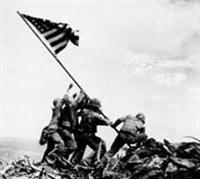 US and Japanese veterans mark 60th anniversary of battle at Iwo Jima
US and Japanese veterans mark 60th anniversary of battle at Iwo Jima
Though Iwo Jima looks to be an unremarkable island with just over a few hundred Japanese soldiers and no other inhabitants, aging American combat veterans and a handful of former Japanese soldiers gathered on a hillside over the landing beaches of the battle of Iwo Jima on Saturday to mark the 60th anniversary of one of the bloodiest and most symbolic battles of the Second World War.
About 50 U.S. vets, many dressed in their uniforms and helmets, gathered with hundreds of family members at a Japanese military base on the island.
A handful of Japanese survivors – only about a dozen are still alive – joined in the “honour reunion,” during which they offered prayers and wreaths for the dead. After the ceremony, they split off to visit battlesites or to pose for photos in a landscape that 60 years ago became a symbol of the savage fighting of the Pacific war.
“The battle of Iwo Jima stands out as an exceptionally hard-fought battle in World War history,” said Kiyoshi Endo, who commanded Japanese troops on the northern part of the island.
During about a month of fighting that began Feb. 19, 1945, some 100,000 Americans battled more than 22,000 Japanese desperate to protect the first Japanese island to be invaded.
Nearly 7,000 Americans died. Fewer than 1,000 of the Japanese survived. Japan surrendered the following August, after one more bloody battle, on Okinawa, and the atomic bombings of Hiroshima and Nagasaki.
Iwo Jima produced one of the iconic images of American combat, when after the battle for Mount Suribachi six troops raised an American flag, a moment that for many Americans symbolizes the Pacific theatre of the Second World War. The Pulitzer Prize-winning photo was later used as the inspiration for the Marine Corps War Memorial in Washington D.C.
For today’s soldiers, the battle of Iwo Jima is the stuff of legend.
“Iwo Jima was the defining moment of the Marine Corps,” said marine 2nd Lieut. Earl Speechley, who has been working out logistics for the anniversary. “Every marine recognizes the significance of the battle.”
“It was the first time I’d seen combat,” recalled Raymond Beadle, 79, from Morgan City, La., who first arrived on Iwo Jima as a 19-year-old private. “It was scary because we could hear the Japanese, but we couldn’t see them. They were all dug in underground.”
Beadle lasted on Iwo for 16 days, until an explosion at an ammo dump blew him about 10 metres into the air, riddling his body with shrapnel and burying him up to his chest in rubble. He was evacuated to Guam and returned to Iwo Jima for the first time on Saturday.
“It’s awesome to be back,” said Beadle, who like many of the veterans carried a bottle to bring some of the island’s sand back home. “It’s so different now. After fighting here, I kind of hoped the Americans would keep it, but I guess we had to give it back.”
The island, about 1,125 kilometres miles southeast of Tokyo, has been used only by the military since the war. About 400 Japanese soldiers are Iwo’s only permanent residents, but the U.S. navy regularly uses an airstrip set up like the flight deck of an aircraft carrier to train pilots.
Most of the American dead have been accounted for, but fewer than half of the Japanese remains have been recovered since Japan’s government first began searches in 1952. Every year the island yields more.
The Iwo Jima of today – considered something of an open grave – looks like an island forgotten by time. It’s tiny, covered with rough jungle and pocked with caves. There are no hotels, no beachside cafes.
Its famous black sand beaches are pristine, save for flotsam washed up from the sea and the remnants of the battle. At the southern tip, a one-lane, dusty road winds its way up Mount Suribachi.
Weeds cover the windows of concrete bunkers, where scorpions nest and rusted cannons sit unattended. Rifles, hand grenades and spent shells of every size are not uncommon inside the countless caves that were formed by lava flows or dug out by the Japanese defenders long ago.
The passage of six decades, however, has not dimmed the island’s status as hallowed ground for the marines.
“The symbolism of Iwo Jima is well understood by even the youngest marines,” said Capt. Joseph Plenzer, a spokesman for the 3rd Marine Expeditionary Force on Okinawa. “It’s something we teach in boot camp.”
ATTENTION READERS
We See The World From All Sides and Want YOU To Be Fully InformedIn fact, intentional disinformation is a disgraceful scourge in media today. So to assuage any possible errant incorrect information posted herein, we strongly encourage you to seek corroboration from other non-VT sources before forming an educated opinion.
About VT - Policies & Disclosures - Comment Policy



